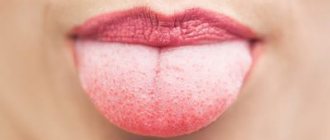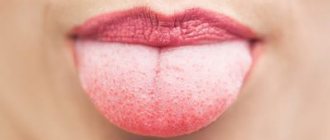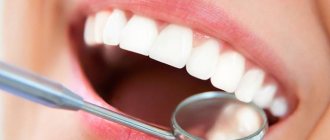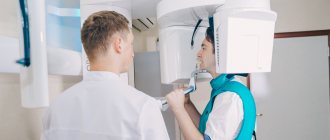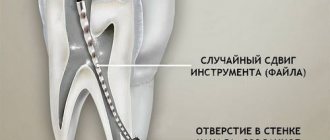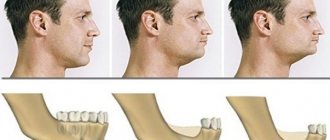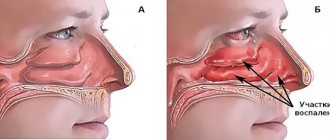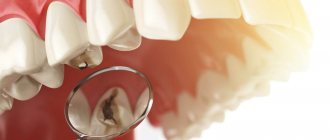How dangerous is this?
A tooth is not a completely foreign body. This is a part of the victim’s body, which is also small and does not have serious dangerous properties such as toxicity. No human tooth is large enough to cause significant problems if it enters the stomach and esophagus.
It is very difficult to swallow the entire jaw
If you swallowed a tooth, you know about it, but you don’t feel it anywhere above the stomach, then there is nothing to worry about - it has already reached the center of the digestive system and will eventually come out naturally. The danger arises when a tooth gets stuck in the esophagus. It doesn’t matter whether it’s a solid tooth or a splinter, there is a high probability that it will have sharp edges. They are too small to seriously damage the mucous membrane of the throat, but they can cause panic and suffocation in sensitive people. It is not easy to push a tooth further out of the esophagus if it is stuck - those who have experienced such trouble associate their sensations with a fish bone stuck in the throat, only smaller.
The most dangerous situation is a tooth getting into the windpipe. This rarely happens, but it is necessary to act quickly and clearly. No fatal cases have been recorded, but the victim may even lose consciousness due to lack of oxygen and a panic attack.
A PIECE IN THE THROAT: WHAT TO DO IF A PERSON CHOCKS OR SWALLOWS AN INEDIBLE OBJECT
Doctor Evgeniy Mitin is again in a hurry to help: now to those who suddenly choked or ate something they were not supposed to eat. What should you do if a person suddenly swallows a pin, needle, toothpick, match, spoon or even a fork? How to help someone who is choking? And is it worth it in such cases to pat on the back, as we are used to? Emergency doctor of the BMC UDP RK Evgeniy Mitin gives the most necessary advice.
IF YOU SWALLOWED INEDIBLE
Let's start with foreign objects, which sometimes, in unexpected situations, end up in our stomach, throat or upper respiratory tract: in professional language they are called foreign bodies.
A foreign body is an object that should not be in the body. This includes household items (spoons, forks, pens, caps), wounding agents (needles, knives, bullets). They can enter the body through the skin or through natural openings.
But now we will talk about foreign bodies that get into the upper respiratory tract and pharynx, which most often happens not intentionally, but accidentally, through negligence, during play, laughter, coughing, or fright.
WHAT YOU CAN SWALLOW
Anything. There may be pins, coins, needles in our body: very often women, when sewing or darning something, place a needle between their lips and then, while sneezing or laughing, also accidentally swallow it. Or we keep matches and toothpicks in our teeth during an active conversation, which can be swallowed during coughing and fear. Small children love to put into their mouths what they find on the floor - small toys, coins.
All these objects, if they are small, can enter the esophagus, go into the stomach and then into the intestines. But the route may be different: a foreign body sometimes gets into the larynx, pharynx and trachea, and even, in some cases, it can reach the bronchi. It all depends on the size. If the swallowed object is quite large, then it usually gets stuck at the level of the pharynx and trachea, blocking breathing. That’s why some manufacturers of household appliances pay special attention to this.
For example, you know that ballpoint pen caps are now made in such a way that they have a gap - the space between the clip on the ballpoint pen cap and the cap itself. If you swallow it, air will still enter the lungs through this lumen. You also probably noticed that there is also a hole at the tip of the cap that can let in enough air to prevent a person from completely suffocating.
WHAT TO DO
Sometimes small foreign objects, when swallowed, smoothly enter the esophagus and stomach, or, as often happens with small children, others may see that the child was playing, holding some object in his mouth, and it suddenly disappeared. In both cases, you need to go to the doctor and have your stomach and esophagus examined. If possible, foreign bodies are removed in such cases. If the object has gone quite deep, and in principle it does not pose a big threat to health, then you can wait until it comes out naturally. If this does not happen, then the foreign body is removed surgically.
But what to do if a foreign body is stuck in the throat?
The upper respiratory tract has its own peculiarity: the glottis, when a foreign object enters them, can close and pinch it. This physiological reaction is called laryngospasm: the body, as they say, catches a foreign object and does not allow it to pass further. But sometimes it slips past the vocal cords, enters the trachea and begins to move as you inhale and exhale. At the same time, it becomes difficult for a person to breathe: an incessant cough begins, and a spasm in the larynx leads to respiratory failure. In this case, you cannot hesitate.
In order to provide first aid if a foreign body enters the pharynx, larynx, or upper respiratory tract, you need to use the Heimlich maneuver.
1. The victim should be turned around with his back and arms tightly clasped between the navel and the upper half of the abdomen.
2. With a sharp upward movement, press the indicated area several times. Thus, the volume of the chest is reduced, as a result of which a foreign body can fly out into the oral cavity.
It is important to act carefully and immediately remove the object from the mouth, because it can get back inside: the first thing the victim strives to do in such a situation is to inhale as much air as possible.
If a person has lost consciousness, then it is necessary to provide assistance in a lying position as follows:
1. sit on the victim’s legs
2. with both hands we press on the same area - between the navel and the upper half of the abdomen from bottom to top
3. We make several sharp pushes.
Also, a person who has lost consciousness due to respiratory failure may develop heart failure, that is, cardiac arrest.
In such cases, you need to start immediately with compressions on the heart, since it is necessary to restore blood circulation and prevent the brain from dying.
In children
Foreign bodies are removed as follows:
1. place the child on the forearm with his face in the palm
2. We put two fingers of the hand in his mouth
3. Apply light blows using jerky movements between the shoulder blades.
IS IT WORTH SLAPPING ON THE BACK?
If an object is stuck in the upper respiratory tract, then hitting the back is useless, since our efforts will not give the necessary impulse. When struck, as a rule, the object jumps to meet the blow, not upward.
There are also cases when a foreign body passes through the pharynx and gets stuck in the esophagus. This phenomenon is called cardiospasm: a large, poorly chewed lump of food gets stuck in the cardia, the first section of the esophagus, which is located at the level of the heart. Vomiting reactions are usually not able to push the piece up, since it is too tightly covered, it is impossible to swallow it further, and it becomes difficult for the person to breathe because the lump compresses the trachea. All this does not exactly cause suffocation: the victim simply begins to panic, because he can neither swallow nor push the piece out. In such cases, we can only help with medicine by administering atropine. This is a medicine that relaxes the muscles of the esophagus and allows stuck food to pass further into the stomach.
For this person, you need to urgently take him to the hospital or call an ambulance. The earlier the better.
SO THIS DOESN'T HAPPEN
It is important to always remember the rule that was repeated to us at the table since childhood, “when I eat, I am deaf and dumb,” so as not to choke and avoid getting a piece of food, fruit pits or jam in the wrong place. You also need to get rid of bad habits, for example, keeping foreign objects in your mouth - toothpicks, pins, paper clips, needles, caps, otherwise someday in an unforeseen situation they may go further than expected.
What can be done and what should not be done?
It is difficult for the victim himself to assess how deeply the tooth has sunk. Independent attempts to remove it from the esophagus will lead to a gag reflex and, possibly, new damage to the oral cavity.
What not to do:
- Trying to reach the tooth with your fingers and especially with foreign objects
- Panic and try to “cough up” the interfering object
- Do nothing and hush up the problem, expecting it to go away on its own
Examine the gums if possible. If a tooth has fallen out or crumbled, then you should know what condition it was in in the near future. A small analysis will help you understand how big the chip is now in your throat; careful palpation of the gums from below will help you determine whether the root remains inside.
If there is no sensation of pain in the larynx or esophagus, then the natural way of exiting the swallowed tooth is most likely and there is no reason for concern
With all this information, go to your dentist or immediately to a traumatologist if you have difficulty breathing. The specialist will tell you what to do now, and at the same time will diagnose other teeth, warning of possible danger.
What to do when your first tooth falls out?
Any pediatric dentist will tell you that the process of changing teeth is not accompanied by pain. In rare cases, a still wobbly incisor can cause discomfort to the baby. If necessary, a pain reliever can be given.
After a tooth has fallen out, it is necessary to examine it. Primary incisors, molars and canines have no roots. Many parents get scared when they don't see them. The lower bone part, in contact with the gum, has an uneven edge, and there is a cavity inside.
If the hole bleeds, which often happens when an incisor is pulled out on its own or accidentally knocked out, you need to apply a sterile cotton swab or a piece of bandage to it and ask the child to hold it for 10 minutes. If the bleeding does not stop, you must immediately contact the nearest medical facility. After the first tooth falls out, it takes one to two weeks for the socket to completely heal. The wound does not require treatment, but to prevent infection, you can rinse your mouth after eating with a low concentration soda solution or an antiseptic. Care must be taken during hygiene procedures. The hard bristles of the brush can damage the socket and cause bleeding. For several days after tooth loss, it is necessary to bypass this area during cleaning.
If a child swallows the first incisor that falls out, there is no need to panic. Within 1-2 days it will be eliminated from the body along with waste products.
Replacing baby teeth with molars is an important stage in a child’s life. It is necessary to tell the child that the new incisors, canines and molars will not change. You should take care of your teeth, brush them regularly and have their condition checked by a pediatric dentist.
Which doctor should I contact? Consultations and treatment by experienced dentists are at your service.
If a crown or filling is swallowed
Fillings with sharp edges carry the same potential danger to the esophageal mucosa as teeth, but they are much smaller in volume. Fillings may also not fall off completely, but rather break off into small fragments that pose almost no danger.
Important! If a fresh filling is swallowed, immediately contact the dentist who placed it. It was either placed incorrectly or fell out due to its unreliability. An infection should not get into a hole recently filled with a filling - the chance of infection and inflammation is very high.
A swallowed crown will not cause any harm in itself, but you should visit the dentist as soon as possible to protect the remaining tooth without a crown.
The crowns are also small in size and if they get into the esophagus and further, they will not cause harm (except for possible micro-scratches). If a filling or crown falls out, you need to immediately fix this problem by installing a new one, even if the tooth does not hurt or bother you in any way. Open dental canals and healthy parts of the tooth will begin to deteriorate after a few weeks from eating food or hot liquids. Due to delay, there may be a need to completely re-treat the tooth.
Is it possible to do without visiting a doctor?
It is possible if no discomfort is felt. Tooth enamel and the “body” of the tooth do not pose any threat even if they are damaged by caries. The body will easily tolerate this and “pass” a foreign object through the gastrointestinal tract without damage.
The closest analogy is to imagine that you swallowed a cherry pit.
A swallowed crown or filling is still worth a visit to the doctor in any case. This way you can prevent further destruction and not endanger neighboring healthy teeth.
Binge eating
This mistake is made by people who are not familiar with the structure of the digestive system. The only option when this solution can be partially correct is that the tooth is stuck at the end of the esophagus and you feel it somewhere above the stomach.
You can eat a small piece of black bread (white is more sticky), fruit or vegetable (preferably with a dense consistency). If after this the sensations do not change in any way, try again in half an hour. You can drink water.
Important! Feelings can be distorted by worry and anxiety - there have been cases when people, frightened by far-fetched threats, feel pressure and scratches from within that are not there. You can check your condition with a moderate sip of water.
In addition, a swallowed crown or other metal element of dental corrective structures will not be visible on an x-ray due to the large amount of food in the stomach and waste in the intestines.
Inducing vomiting
Inducing vomiting is a very bad idea. If a tooth is stuck in the esophagus, this may not help, and getting it out of the stomach at the cost of dehydration and possible digestive upset is too costly in terms of the resources of the human body. It should be remembered that vomiting is an emergency defense mechanism, and not a normal state of the body. To cause it yourself means to consciously undermine your health.
Even if the tooth really got stuck on the way from the esophagus to the stomach, a sharp influx of semi-digested food from below will push it with enough force for the sharp edges to leave a scratch on the mucous membrane.
Are there medications that will improve the situation?
There are no solutions aimed at solving this specific problem. Such medications are not sold because the problem is not significant and will soon resolve itself or with minimal help from doctors.
Under no circumstances should you use drugs that artificially speed up digestion - this will cause no less harm to the body than vomiting.
Dehydration, stopping the healthy digestive process, pain, loss of appetite - all these symptoms can appear if you take the drug without appropriate indications.
If the tooth is severely stuck and scratched, no medications will help - go to the emergency room, where foreign objects are pulled out of the esophagus every day. This can only be done by a professional physician who knows how the esophagus works and will not damage it. If you don’t want to wait in line at the clinic and search for the right office, you can find a private dental office - usually there is at least one of these in every area.
Prevention
- A healthy lifestyle and daily oral care using personal hygiene products will help prevent the development of gumboil. For cleaning, use a medium-hard brush.
- After each meal, it is recommended to rinse your mouth with a special mouthwash or use dental floss. Instead of a pharmaceutical composition, it is allowed to use an aqueous solution of food salt, sea salt or an alcoholic tincture of propolis.
- Do not use non-sterile objects as toothpicks. Such actions lead to mechanical injuries and infection.
- Periodic professional dental cleaning helps remove stone, which provokes the development of inflammation of the gums with pus.
- The daily diet must be supplemented with fresh vegetables and fruits. Apples, carrots and other solid plant foods cleanse plaque from enamel and strengthen teeth.
It is also important to treat dental defects immediately and undergo regular clinical examinations at least twice a year. It is much easier to prevent dental disease than to treat its negative consequences. You should be attentive to your health and not ignore the warning signals that your body gives.
What to do if a child swallows a tooth?
Children are the ones who swallow teeth most often - they chew faster, are in a hurry and know little about handling sick and weak teeth. A parent may not know for a long time that a child’s molar is weak or crumbling; children often hide such information in order to delay a visit to the dentist.
Young children lose their baby teeth, which they often accidentally swallow.
It is better to explain to the child in advance that there will be many more teeth that fall out and you should handle them more carefully. A tooth scratching the throat will cause a baby much more anxiety than an adult - he may start crying, unable to get rid of the irritant.
Treatment of caries of primary teeth: features of the process in children
It is necessary to treat baby teeth using gentle and painless methods.
Five rules of child therapy:
- anesthesia in two stages - anesthesia of the gum area with a gel or spray with lidocaine, then an injection. The finest (carpule) needles are intended for children;
- the injection contains a safe concentration of anesthetic - 2% lidocaine or 4% articaine. Children are administered from a sixth to half of the “adult” dose (depending on the child’s weight). Anesthetics with adrenaline are contraindicated for children under 4 years of age;
- filling materials containing fluorides and other minerals are applied in one go;
Diagnosis of caries
The development of caries in children occurs much more rapidly and aggressively than the same process in adults. The enamel of baby teeth is weaker, permeated with micropores into which bacteria can easily penetrate, so it only takes a few months from the first manifestation of the carious process for the tooth to be completely destroyed. It is for this reason that the frequency of visiting a pediatric dentist is every 3-4 months, this will allow timely treatment of dental caries, which occurs rapidly in children.
Symptoms of carious tooth decay at different stages:
- Initial caries is characterized by the appearance of white (chalky) spots on the enamel. Then they turn yellow, the surface of the tooth becomes rough. At this stage, the baby does not feel pain, but a reaction to high and low food temperatures may already appear. This is initial caries, and it can still be cured without using a drill. Moreover, this is the only stage of development of the disease at which dental treatment in children takes place without installing a filling;
- Average caries is already the destruction of enamel and the formation of a carious “hole”, sharp pain during mechanical action and the use of chemical irritants. At the bottom of the carious cavity, softened dentin and food debris accumulate. Prevention and gentle methods will no longer help - a full filling is needed. Treatment in children at this stage is already moving to another level - the open carious cavity in the tooth must be cleaned and hermetically sealed with filling materials;
- deep caries - the carious “hole” expands and becomes noticeable, the tooth enamel and most of the dentin are affected. At the bottom of the cavity, upon probing, the doctor discovers a large accumulation of dead softened tissue. Treatment of teeth with deep caries in children is carried out with filling. But if the enamel is significantly destroyed and there is nowhere to put a filling, the baby tooth is removed.
Visual examination and probing are sufficient measures to determine the stage of caries in a child. But if the carious lesion is located in a place that is difficult to access, a specialist may order an x-ray or conduct a study using an intraoral camera. If the doctor has doubts about the presence of caries at the initial stage, he uses a caries detector - a liquid that colors the infected tissue pink or blue. The drug is harmless to the child.
Treatment of dental caries in children at an early age
At an early stage, treatment of caries of primary teeth in children is carried out without a drill using gentle methods:
- silvering - technology is considered outdated, however, it is widely used in most dental clinics. The carious area of enamel is treated with a 30% solution of silver nitrate, which has bactericidal properties. It quickly and painlessly destroys cariogenic microflora, without requiring the use of anesthesia. However, after using the solution, silver stains baby teeth a persistent black color, which can lead to the development of psychological complexes in a child. The method is recommended for children under 3 years of age;
- fluoridation or remineralization - restoration and strengthening of enamel, saturation of weakened areas with useful minerals. Already at the child’s first visit to the dentist, he treats the surface of the teeth with a special solution containing fluoride, phosphorus, and other microelements. The technology of such treatment stops the development of dental caries in children at the stain stage, while at the same time being an excellent prevention of the disease for about six months. Recommended for children over 6 years old;
- Ozone therapy is a non-contact method for children of any age. Ozone is a powerful oxidizing agent; it painlessly destroys pathogenic microflora in just 10-20 seconds (the duration of the procedure). Gas under pressure is supplied directly to the affected area through a thin tip. After such treatment, the carious process is stopped;
- Icon – infiltration method involves treating the carious area with a special etching gel that softens infected tissue. The doctor gently washes them with a stream of abrasive mixture, then dries the surface with warm air and applies the Icon liquid infiltrate filling. The light of the polymerization lamp helps it quickly harden and “seal” all the pores on the enamel, smooth out irregularities and roughness, and “preserve” the process of caries development. Dental treatment for children using this technology takes 15-20 minutes and is used from the age of 3 years.
Filling baby teeth
A standard template has been developed for this procedure: carious destroyed tissues are carefully cleaned out using hand tools or a drill. Then the cavity is washed with a disinfectant solution and filled with filling material. The last step of the procedure is grinding and polishing the surface. The filling material is selected in such a way that it is not harder than the enamel of a baby tooth, which wears off very quickly. This is a natural process and a filling that is too hard will soon begin to protrude above the edges.
For the treatment of primary teeth in children, glass ionomer cements are more suitable than others, which, unlike photocomposite ones, are applied not layer by layer, but at a time. The composition of these cements includes calcium and fluoride compounds, which help strengthen dental tissues. The material is quite soft and wears off evenly with tooth enamel.
Many modern clinics use another filling material that is interesting in all respects – Twinky Star colored fillings for children. Children really like the bright colors. Moreover, the child can choose the color himself. This is very important for children - to have this opportunity means to be involved in the treatment process. The filling combines the properties of glass ionomer cement with photopolymer, is safe for health, and enriched with beneficial fluoride ions.
Treatment of caries of permanent teeth in children
The same methods are used to treat permanent teeth in children and adults. The basis of therapy remains filling with a photopolymer composite, which is considered the ideal material for this purpose - strength, aesthetics of natural enamel, the ability to choose the optimal shade.
Filling stages:
- local anesthesia;
- removal of carious tissue and softened dentin;
- antiseptic treatment;
- drying;
- applying an insulating layer of phosphate cement;
- Filling with a composite – layer-by-layer application with illumination of each layer with a photopolymer lamp.
In the early stages of caries, ozone therapy, Icon, and enamel remineralization can be used. Silvering on permanent teeth is contraindicated, since after such treatment they will remain black for the rest of their lives.
